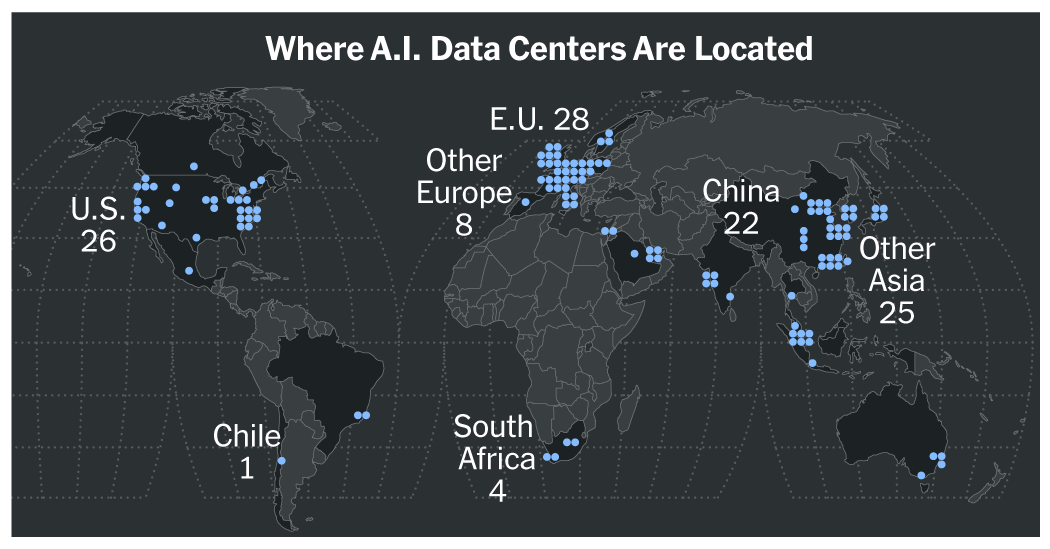Table of Contents
Where A.I. Data Centers Are Located
Only 32 nations, mostly in the Northern Hemisphere, have A.I.-specialized data centers.
Last month, Sam Altman, the chief executive of the artificial intelligence company OpenAI, donned a helmet, work boots and a luminescent high-visibility vest to visit the construction site of the company’s new data center project in Texas.
Bigger than New York’s Central Park, the estimated $60 billion project, which has its own natural gas plant, will be one of the most powerful computing hubs ever created when completed as soon as next year.
Around the same time as Mr. Altman’s visit to Texas, Nicolás Wolovick, a computer science professor at the National University of Córdoba in Argentina, was running what counts as one of his country’s most advanced A.I. computing hubs. It was in a converted room at the university, where wires snaked between aging A.I. chips and server computers.
“Everything is becoming more split,” Dr. Wolovick said. “We are losing.”
Artificial intelligence has created a new digital divide, fracturing the world between nations with the computing power for building cutting-edge A.I. systems and those without. The split is influencing geopolitics and global economics, creating new dependencies and prompting a desperate rush to not be excluded from a technology race that could reorder economies, drive scientific discovery and change the way that people live and work.
The biggest beneficiaries by far are the United States, China and the European Union. Those regions host more than half of the world’s most powerful data centers, which are used for developing the most complex A.I. systems, according to data compiled by Oxford University researchers. Only 32 countries, or about 16 percent of nations, have these large facilities filled with microchips and computers, giving them what is known in industry parlance as “compute power.”
The United States and China, which dominate the tech world, have particular influence. American and Chinese companies operate more than 90 percent of the data centers that other companies and institutions use for A.I. work, according to the Oxford data and other research.
In contrast, Africa and South America have almost no A.I. computing hubs, while India has at least five and Japan at least four, according to the Oxford data. More than 150 countries have nothing.
Today’s A.I. data centers dwarf their predecessors, which powered simpler tasks like email and video streaming. Vast, power-hungry and packed with powerful chips, these hubs cost billions to build and require infrastructure that not every country can provide. With ownership concentrated among a few tech giants, the effects of the gap between those with such computing power and those without it are already playing out.
The world’s most used A.I. systems, which power chatbots like OpenAI’s ChatGPT, are more proficient and accurate in English and Chinese, languages spoken in the countries where the compute power is concentrated. Tech giants with access to the top equipment are using A.I. to process data, automate tasks and develop new services. Scientific breakthroughs, including drug discovery and gene editing, rely on powerful computers. A.I.-powered weapons are making their way onto battlefields.
Nations with little or no A.I. compute power are running into limits in scientific work, in the growth of young companies and in talent retention. Some officials have become alarmed by how the need for computing resources has made them beholden to foreign corporations and governments.
“Oil-producing countries have had an oversized influence on international affairs; in an A.I.-powered near future, compute producers could have something similar since they control access to a critical resource,” said Vili Lehdonvirta, an Oxford professor who conducted the research on A.I. data centers with his colleagues Zoe Jay Hawkins and Boxi Wu.
A.I. computing power is so precious that the components in data centers, such as microchips, have become a crucial part of foreign and trade policies for China and the United States, which are jockeying for influence in the Persian Gulf, in Southeast Asia and elsewhere. At the same time, some countries are beginning to pour public funds into A.I. infrastructure, aiming for more control over their technological futures.
The Oxford researchers mapped the world’s A.I. data centers, information that companies and governments often keep secret. To create a representative sample, they went through the customer websites of nine of the world’s biggest cloud-service providers to see what compute power was available and where their hubs were at the end of last year. The companies were the U.S. firms Amazon, Google and Microsoft; China’s Tencent, Alibaba and Huawei; and Europe’s Exoscale, Hetzner and OVHcloud.
The research does not include every data center worldwide, but the trends were unmistakable. U.S. companies operated 87 A.I. computing hubs, which can sometimes include multiple data centers, or almost two-thirds of the global total, compared with 39 operated by Chinese firms and six by Europeans, according to the research. Inside the data centers, most of the chips — the foundational components for making calculations — were from the U.S. chipmaker Nvidia.
“We have a computing divide at the heart of the A.I. revolution,” said Lacina Koné, the director general of Smart Africa, which coordinates digital policy across the continent. He added: “It’s not merely a hardware problem. It’s the sovereignty of our digital future.”
‘Sometimes I Want to Cry’
There has long been a tech gap between rich and developing countries. Over the past decade, cheap smartphones, expanding internet coverage and flourishing app-based businesses led some experts to conclude that the divide was diminishing. Last year, 68 percent of the world’s population used the internet, up from 33 percent in 2012, according to the International Telecommunication Union, a United Nations agency.
With a computer and knowledge of coding, getting a company off the ground became cheaper and easier. That lifted tech industries across the world, be they mobile payments in Africa or ride hailing in Southeast Asia.
But in April, the U.N. warned that the digital gap would widen without action on A.I. Just 100 companies, mostly in the United States and China, were behind 40 percent of global investment in the technology, the U.N. said. The biggest tech companies, it added, were “gaining control over the technology’s future.”
Few Companies Control A.I. Computing
Tiles show total availability zones for A.I. offered by each company, a metric used by researchers as a proxy for A.I. data centers.
The gap stems partly from a component everyone wants: a microchip known as a graphics processing unit, or GPU. The chips require multibillion-dollar factories to produce. Packed into data centers by the thousands and mostly made by Nvidia, GPUs provide the computing power for creating and delivering cutting-edge A.I. models.
Obtaining these pieces of silicon is difficult. As demand has increased, prices for the chips have soared, and everyone wants to be at the front of the line for orders. Adding to the challenges, these chips then need to be corralled into giant data centers that guzzle up dizzying amounts of power and water.
Many wealthy nations have access to the chips in data centers, but other countries are being left behind, according to interviews with more than two dozen tech executives and experts across 20 countries. Renting computing power from faraway data centers is common but can lead to challenges, including high costs, slower connection speeds, compliance with different laws, and vulnerability to the whims of American and Chinese companies.
Qhala, a start-up in Kenya, illustrates the issues. The company, founded by a former Google engineer, is building an A.I. system known as a large language model that is based on African languages. But Qhala has no nearby computing power and rents from data centers outside Africa. Employees cram their work into the morning, when most American programmers are sleeping, so there is less traffic and faster speeds to transfer data across the world.
“Proximity is essential,” said Shikoh Gitau, 44, Qhala’s founder.
“If you don’t have the resources for compute to process the data and to build your A.I. models, then you can’t go anywhere,” said Kate Kallot, a former Nvidia executive and the founder of Amini, another A.I. start-up in Kenya.
In the United States, by contrast, Amazon, Microsoft, Google, Meta and OpenAI have pledged to spend more than $300 billion this year, much of it on A.I. infrastructure. The expenditure approaches Canada’s national budget. Harvard’s Kempner Institute, which focuses on A.I., has more computing power than all African-owned facilities on that continent combined, according to one survey of the world’s largest supercomputers.
Brad Smith, Microsoft’s president, said many countries wanted more computing infrastructure as a form of sovereignty. But closing the gap will be difficult, particularly in Africa, where many places do not have reliable electricity, he said. Microsoft, which is building a data center in Kenya with a company in the United Arab Emirates, G42, chooses data center locations based largely on market need, electricity and skilled labor.
“The A.I. era runs the risk of leaving Africa even further behind,” Mr. Smith said.
Jay Puri, Nvidia’s executive vice president for global business, said the company was also working with various countries to build out their A.I. offerings.
“It is absolutely a challenge,” he said.
Chris Lehane, OpenAI’s vice president of global affairs, said the company had started a program to adapt its products for local needs and languages. A risk of the A.I. divide, he said, is that “the benefits don’t get broadly distributed, they don’t get democratized.”
Tencent, Alibaba, Huawei, Google, Amazon, Hetzner and OVHcloud declined to comment.
The gap has led to brain drains. In Argentina, Dr. Wolovick, 51, the computer science professor, cannot offer much compute power. His top students regularly leave for the United States or Europe, where they can get access to GPUs, he said.
“Sometimes I want to cry, but I don’t give up,” he said. “I keep talking to people and saying: ‘I need more GPUs. I need more GPUs.’”
Few Choices
The uneven distribution of A.I. computing power has split the world into two camps: nations that rely on China and those that depend on the United States.
The two countries not only control the most data centers but are set to build more than others by far. And they have wielded their tech advantage to exert influence. The Biden and Trump administrations have used trade restrictions to control which countries can buy powerful A.I. chips, allowing the United States to pick winners. China has used state-backed loans to encourage sales of its companies’ networking equipment and data centers.
The effects are evident in Southeast Asia and the Middle East.
In the 2010s, Chinese companies made inroads into the tech infrastructure of Saudi Arabia and the Emirates, which are key American partners, with official visits and generous financing. The United States sought to use its A.I. lead to push back. In one deal with the Biden administration, an Emirati company promised to keep out Chinese technology in exchange for access to A.I. technology from Nvidia and Microsoft.
In May, President Trump signed additional deals to give Saudi Arabia and the Emirates even more access to American chips.
A similar jostling is taking place in Southeast Asia. Chinese and U.S. companies like Amazon, Alibaba, Nvidia, Google and ByteDance, the owner of TikTok, are building data centers in Singapore and Malaysia to deliver services across Asia.
Globally, the United States has the lead, with American companies building 63 A.I computing hubs outside the country’s borders, compared with 19 by China, according to the Oxford data. All but three of the data centers operated by Chinese firms outside their home country use chips from Nvidia, despite efforts by China to produce competing chips. Chinese firms were able to buy Nvidia chips before U.S. government restrictions.
Where the World Gets Its A.I.
Companies and countries throughout the world rely mostly on major American and Chinese cloud operators for A.I. facilities.
Even U.S.-friendly countries have been left out of the A.I. race by trade limits. Last year, William Ruto, Kenya’s president, visited Washington for a state dinner hosted by President Joseph R. Biden Jr. Several months later, Kenya was omitted from a list of countries that had open access to needed semiconductors.
That has given China an opening, even though experts consider the country’s A.I. chips to be less advanced. In Africa, policymakers are talking with Huawei, which is developing its own A.I. chips, about converting existing data centers to include Chinese-made chips, said Mr. Koné of Smart Africa.
“Africa will strike a deal with whoever can give access to GPUs,” he said.
If You Build It
Alarmed by the concentration of A.I. power, many countries and regions are trying to close the gap. They are providing access to land and cheaper energy, fast-tracking development permits and using public funds and other resources to acquire chips and construct data centers. The goal is to create “sovereign A.I.” available to local businesses and institutions.
In India, the government is subsidizing compute power and the creation of an A.I. model proficient in the country’s languages. In Africa, governments are discussing collaborating on regional compute hubs. Brazil has pledged $4 billion on A.I. projects.
“Instead of waiting for A.I. to come from China, the U.S., South Korea, Japan, why not have our own?” Brazil’s president, Luiz Inácio Lula da Silva, said last year when he proposed the investment plan.
Even in Europe, there is growing concern that American companies control most of the data centers. In February, the European Union outlined plans to invest 200 billion euros for A.I. projects, including new data centers across the 27-nation bloc.
Mathias Nobauer, the chief executive of Exoscale, a cloud computing provider in Switzerland, said many European businesses want to reduce their reliance on U.S. tech companies. Such a change will take time and “doesn’t happen overnight,” he said.
Still, closing the divide is likely to require help from the United States or China.
Cassava, a tech company founded by a Zimbabwean billionaire, Strive Masiyiwa, is scheduled to open one of Africa’s most advanced data centers this summer. The plans, three years in the making, culminated in an October meeting in California between Cassava executives and Jensen Huang, Nvidia’s chief executive, to buy hundreds of his company’s chips. Google is also one of Cassava’s investors.
The data center is part of a $500 million effort to build five such facilities across Africa. Even so, Cassava expects it to address only 10 percent to 20 percent of the region’s demand for A.I. At least 3,000 start-ups have expressed interest in using the computing systems.
“I don’t think Africa can afford to outsource this A.I. sovereignty to others,” said Hardy Pemhiwa, Cassava’s chief executive. “We absolutely have to focus on and ensure that we don’t get left behind.”


